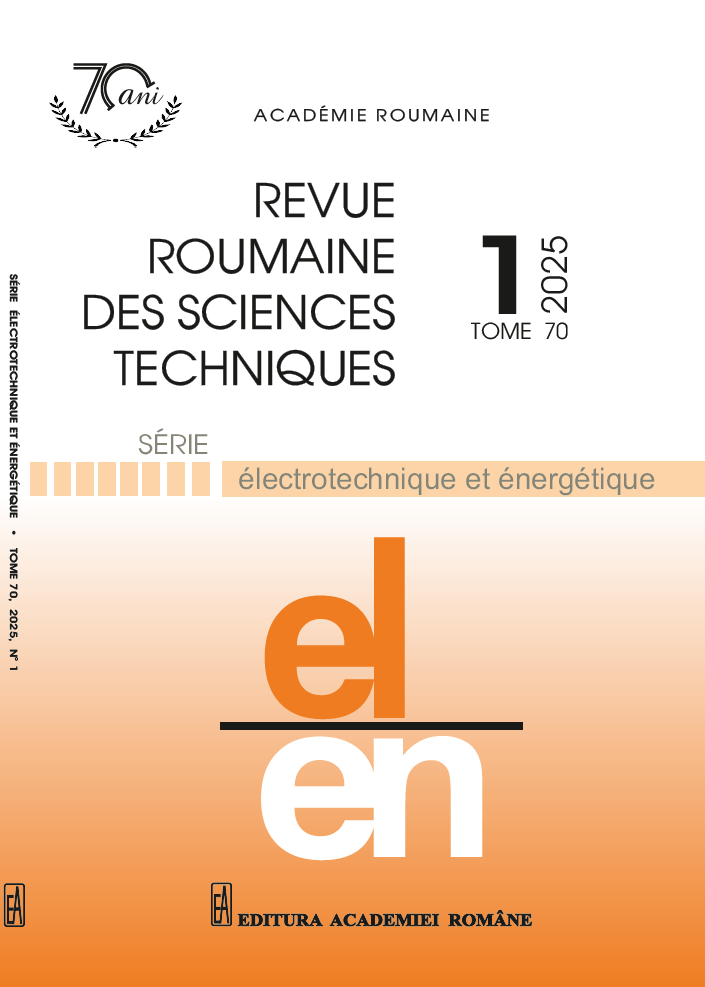COMPLEMENTS REGARDING THE DYNAMIC STABILITY OF THE SYNCHRONOUS MACHINE
DOI:
https://doi.org/10.59277/RRST-EE.2025.1.5Keywords:
Dynamic stability, Synchronous machine, Mathematical dynamic modelsAbstract
This paper analyzes factors conditioning the dynamic stability of a high power synchronous motor, by using non-linear dynamic mathematical models. There is noticed a structural difference between the dynamic angular characteristics compared to the static angular characteristics. There result notable electrical, magnetic and mechanical stresses, which must be necessarily considered, in the stage of design and exploitation.
References
(1) B. Adkins, The general theory of electrical machines, J. Wiley, New York (1959).
(2) I. Boldea, Electric machine parameters (in Romanian), Ed. Academiei (1991).
(3) N. Canay, Allgemeine theorie der synchron- und asynchronmaschinen in der operator–matrix–darstellung, Archiv fur Elektrotechnik, 46, 2, pp. 83–102 (1961).
(4) C.H. Concordia, Synchronous machines, J. Willey, New York (1951).
(5) I. Dumitrache, Automatica, Ed. Academiei Romane, Bucuresti (2016).
(6) E.I. Kazovschi, Perehodnîe procesî electriceschih maşinah per. toka, Ecad. Sc., Moscow–Leningrad (1962).
(7) P. Krause, Analysis of electric machinery, McGraw-Hill, New York (1986).
(8) K.P. Kovacs, I. Racz, Transient regimes of A.C. machines, Springer Verlag (1995).
(9) T.H. Laible, Die theorie der synchronmaschine in nichtstationaren betrieb, Springer Verlag, Berlin (1952).
(10) E. Levi, Saturation modeling in D-Q axis models of salient pole synchronous machines, IEEE Trans. on Energy Conversion, 14, 1, pp. 44–50 (1999).
(11) V. Lyon, Transient analysis of A.C. machinery, J. Wiley, New York (1954).
(12) P. Vas, Generalized analysis of saturated AC machines, Archiv f. Elektrotechnik, 64, 1–2 (1981).
(13) J.H. Walker, Large synchronous machines: Design, manufacture and operation, Oxford, UK, Clarendon (1981).
(14) I. Boldea, Variable speed generators, CRC Press, Boca Raton, FL (2016).
(15) A. Câmpeanu, About the saturation effect in the alternative current machine equations, Rev. Roum. Sci. Techn. – Électrotechn. et Énerg, 38, 4, pp. 539–546 (1993).
(16) A. Câmpeanu, Transient performance of the saturated induction machine, Electrical Engineering, Archiv fur Elektrotechnik, 78, 4, pp. 241–247 (1995).
(17) A. Câmpeanu, Nonlinear dynamical models of saturated salient pole synchronous machine, Rev. Roum. Sci. Techn. – Électrotechn. et Énerg., 47, 3, pp. 307–317 (2002).
(18) A. Câmpeanu, S. Ivanov, Recurrence relations in saturated AC machines modeling, EPE – PMC, Riga (2004).
(19) A. Câmpeanu, Mașini electrice. Probleme fundamentale, speciale și de funcționare optimala, Editura Scrisul Românesc (1987).
(20) A. Câmpeanu, R. Munteanu, I.V. Iancu, About dynamic stability of high-power synchronous machine. A review, Rev. Roum. Sci. Techn. – Électrotechn. et Énerg., 62, 1, Bucharest (2017).
(21) A. Câmpeanu, Über eine besondere betriebsweise von synchronmaschinen, Archiv fur Elektrotechnik, 61, pp. 33–40 (1979).
(22) A. Câmpeanu, I. Cauti, On the transient behavior of saturated synchronous machines, Rev. Roum. Sci. Techn. – Électrotechn. et Énerg., 53, 4, pp. 367–376 (2008).
(23) A. Câmpeanu, M. Stiebler, Modeling of saturation in salient pole synchronous machine, Proc. of OPTIM, Brașov, Romania (2010).
(24) A. Câmpeanu, M. Stiebler, Modeling and simulation of dynamical processes in high power salient pole synchronous machines, Rev. Roum. Sci. Techn. – Électrotechn. et Énerg., 56, 2, pp. 179–188 (2011).
(25) A. Câmpeanu, S. Enache, I. Vlad, G. Liuba, L. Augustinov, I. Cauti, Simulation of asynchronous operation in high power salient pole synchronous machines, Proc. ICEM, Marseille (2012).
(26) A. Câmpeanu, I. Vlad, T. Cimpeanu, S. Enache, I. Cauti, Simulation of dynamic single supply back-to-back high-power synchronous machines operation, Rev. Roum. Sci. Techn. – Électrotechn. et Énerg., 59, 3, pp. 228–236 (2014).
(27) L. Pierrat, E. Dejaeger, M.S. Garrido, Models unification for the saturated synchronous machines, Proc. Int. Conf. on Evolution and Modern Aspects of Synchronous Machines, Zürich, Switzerland, pp. 44–48 (1991).
(28) A.N. El-Serafi, J. Wu, Saturation representation in synchronous machine models, Elec. Machines and Power Systems, 20, pp. 355–369 (1992).
(29) S. Yamamoto, T. Ara, K. Matsuse, A method to calculate transient characteristics of synchronous reluctance motor considering iron loss and cross-magnetic saturation, IEEE Trans. Ind. Appl., 43, 1, pp. 47–56 (2007).
Downloads
Published
Issue
Section
License
Copyright (c) 2025 REVUE ROUMAINE DES SCIENCES TECHNIQUES — SÉRIE ÉLECTROTECHNIQUE ET ÉNERGÉTIQUE

This work is licensed under a Creative Commons Attribution-NonCommercial-NoDerivatives 4.0 International License.


